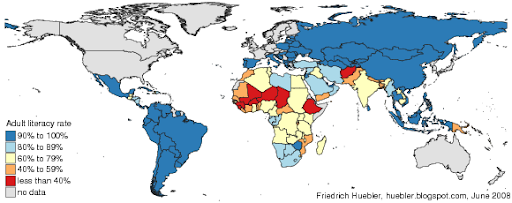Before the update of May, the UIS database contained adult literacy rates for 136 countries and territories. For 10 countries, the most recent data was from 2005, for 30 countries from 2004, and for 5 countries from 2003. The remaining countries had data from 2002 or earlier years.
The UIS Data Centre now offers the adult literacy rate for 145 countries and territories. For 115 countries, data from 2007 is available. The map below displays the adult literacy rate for all countries with data.
Adult literacy rates by country, 2007

Source: UNESCO Institute for Statistics, Data Centre, May 2008
The unweighted mean of the adult literacy rate is 81.2 percent. In 71 countries - including most of Eastern Europe, East and Southeast Asia, and Latin America - 90 percent or more of the adult population can read and write. The highest adult literacy rate, 99.8 percent, is reported for Cuba, Estonia and Latvia. Most countries without data are in the group of industrialized countries, where literacy rates are also likely to be above 90 percent. In 23 countries, the adult literacy rate is between 80 and 90 percent.
At the other extreme are eight countries with literacy rates below 40 percent: Mali (23.3), Chad (25.7), Afghanistan (28.0), Burkina Faso (28.7), Guinea (29.5), Niger (30.4), Ethiopia (35.9), and Sierra Leone (38.1). Another 16 countries have literacy rates between 40 and 60 percent: Benin (40.5), Senegal (42.6), Mozambique (44.4), Central African Republic (48.6), Cote d'Ivoire (48.7), Togo (53.2), Bangladesh (53.5), Pakistan (54.9), Liberia (55.5), Morocco (55.6), Bhutan (55.6), Mauritania (55.8), Nepal (56.5), Papua New Guinea (57.8), Yemen (58.9), and Burundi (59.3). Almost all of these countries are in Sub-Saharan Africa and South Asia.
Finally, the world's two largest countries in terms of population have very different literacy rates. In China, the adult literacy rate is 93.3 percent. In India, only 66 percent of the adult population can read and write.
The complete dataset with adult and youth literacy rates is available at the UIS Data Centre.
Related articles
- Literacy data from the UNESCO Institute for Statistics
- UNESCO releases data from 2007 education survey
- Adult literacy rates (article of July 2007)
- Youth literacy rates (article of July 2007)
- Disparity between adult and youth literacy
- Disparity between male and female literacy rates
- Adult literacy in Sub-Saharan Africa
Friedrich Huebler, 15 June 2008, Creative Commons License
Permanent URL: http://huebler.blogspot.com/2008/06/adult-literacy.html
in the light of my past 20 years experience i really doughtfull about the educational data of almost all countries who has low rate of literacy.
ReplyDeletewe never eliminate illiteracy from world without direct assessment.
it is big responsiblity of institutes,organization like unesco,unicef iil etc .to ensure the direct assessment of communities before starting a program .the direct assessment of community is very simple & easy task .
Zakia, some DHS and MICS surveys use a simple reading test to assess literacy. Results from such tests are described in two recent articles on this site: "Adult literacy in Sub-Saharan Africa" and "Reported and tested literacy in Nigeria".
ReplyDelete